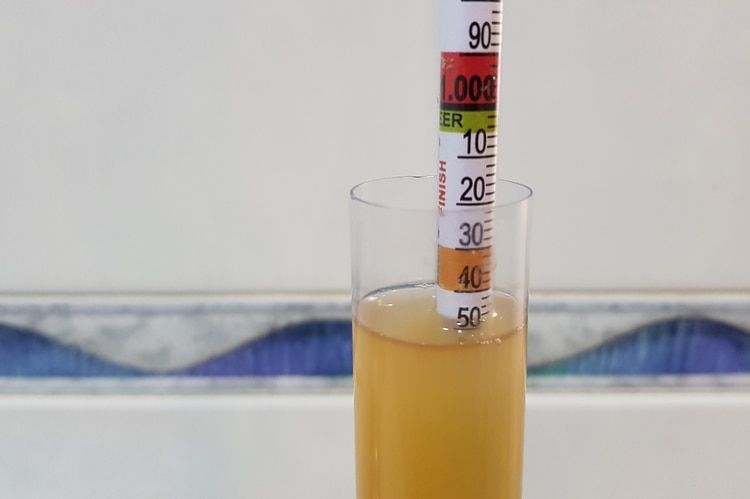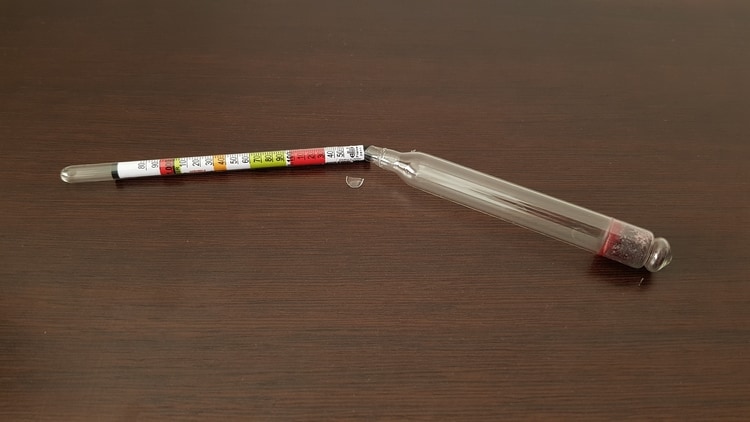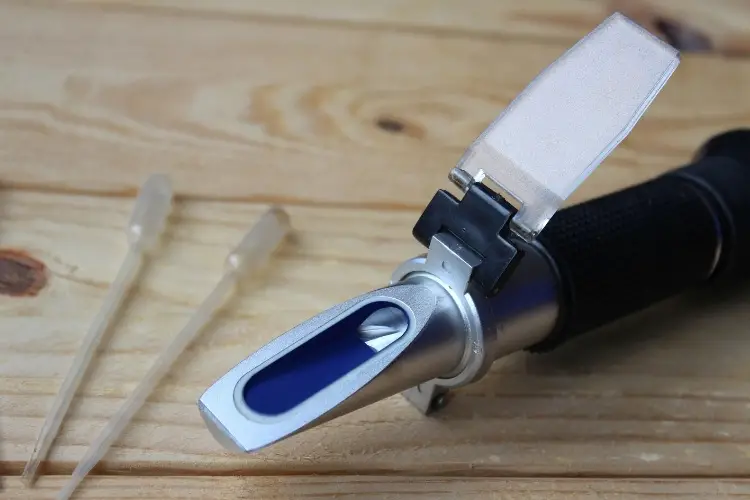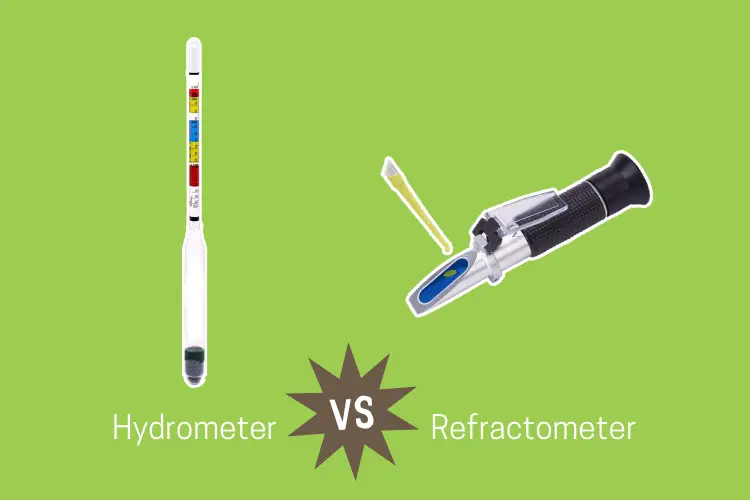Although brewing beer is a fun hobby that anyone can enjoy with the right equipment and some practice, it is also a science.
When you brew beer, you’re effectively controlling the transformation of large carbohydrate molecules into fermentable sugars. Then you allow live yeast to turn them into alcohol, all while making sure you get the most flavor possible and the desired mouthfeel.
Getting it right requires some care: the right temperatures through the process, the exact boiling time and a controlled fermentation; it all counts.
The most important thing to consider, really, is assessing how much sugar there’s in your wort and then following those sugar levels as the yeast turns the sugar into alcohol.
Here’s where you can use either a hydrometer or a refractometer. They’ll measure the dissolved solids (sugar) in your wort or fermenting beer, each in a unique way.
Here’s a quick recap of the pros and cons of the two measuring instruments.
Hydrometer Pros & Cons
| Pros | Cons |
|---|---|
| Inexpensive | Fragile |
| Easy to use | Measurements affected by temperature |
| Calibration not necessary | Requires a large sample |
| Can use during the entire brewing and fermenting process |
Check out this hydrometer to add to your brewing gear. It comes with a glass test jar, a storage case, a cleaning brush, and a cleaning cloth.
No products found.
Refractometer Pros & Cons
| Pros | Cons |
|---|---|
| Works with only one drop | More expensive |
| Can measure hot liquid | Requires converting Brix units to Specific Gravity |
| Very precise | Not ideal for measuring sugar during the last stages of fermentation |
| Needs calibration |
Here’s an awesome portable refractometer you might want to consider. Easy to use and calibrate, this will be a lovely addition to your tool kit.
No products found.
When to use a hydrometer or refractometer?
- After mashing and sparging your grains, you want to know the gravity before the boil.
- You’ll need to assess your Original Gravity (OG) after the boil to follow your fermentation process.
- You’ll want to determine your Final Gravity (FG) toward the end of the fermentation process to know when the beer is done.
What units do you use to measure the sugar levels?
When you measure a liquid’s density, in this case, the amount of fermentable sugars in your wort or beer, you’ll generally measure the Specific Gravity — it determines the liquid’s density vs plain water.
You can also measure sugar in Brix units, a scale specifically designed to measure sugar dissolved in a liquid.
Without further ado, here are the two tools that’ll help you measure your wort and beer’s density.
What does a hydrometer do?
A hydrometer is a relatively simple gadget that you fill with a liquid sample. The hydrometer then floats on the sample, displacing the liquid to show a measurement imprinted in the hydrometer’s cylinder. More often than not, measured in Specific Gravity (SG).

Although inexpensive and relatively easy to use, using a hydrometer does require you to have a sample spoon or turkey baster (that’s what I use). And during the fermentation, although you could sanitize the appliance to rescue the sample (you don’t want your beer to get infected at this point), in most cases, that’s beer wasted. And not only once.
But 2, 3, 4 or more times if you’re checking your density daily.
You should also consider hydrometers don’t require calibration, which is a big plus, but they can be fragile.
I broke one already and I consider myself a cautious person. When I went to my home brew shop to buy a new one, the lady told me “oh, you’re the third one already today”. Like I said. Fragile.

Considering there are many hydrometer models in the market and that they’re all relatively cheap, get the best one you can — this is one of those things you shouldn’t mind splurging on.
On the negative side, hydrometer measurements can be imprecise if the liquid is too hot, which is a problem when measuring your boiling wort’s density.
But if you’re in a rush, you can just use a calculator to adjust and get the real Specific Gravity.
Ultimately, if you’re making beer at home, you must own a hydrometer, it’s an essential tool, and you simply can’t brew without one.
The question is, can a refractometer do the same thing? And what’s the difference?
What does a refractometer do?
A refractometer is a tool that uses light refraction to determine the amount of sugar dissolved in a liquid. Winemakers use this fantastic gadget to determine if the grapes are ready for harvest, and you can use it while brewing too.

The main difference between a refractometer and a hydrometer is that, although both measure more or less the same thing, they do it in entirely different ways.
A hydrometer measures liquid density, while a refractometer uses light to determine the sugar dissolved in the liquid.
You’ll need a relatively large liquid sample to use a hydrometer, but a refractometer only needs a drop.
You need not worry about the liquid’s temperature either, as a drop of any liquid cools too fast to matter.
The refractometer, though, will give you a sugar measurement in Brix, so you must convert the measurement — there are calculators like this one for that.
Yes, the refractometer is more expensive than a hydrometer, but it is ideal for determining the sugar in your wort when it matters most — before and after the boiling process.
Yes, you can also use it from start to finish, and it’s handheld, so it’s ideal for when you’re brewing in tighter places with little counter space.
There’s a downside, though; as the yeast turns the sugar into alcohol late in the fermentation process, the refractometer loses its precision. You won’t have that problem with a hydrometer.
That’s how you use a refractometer:
Which one to buy? Hydrometer or Refractometer?
If you want to brew beer at home or even go pro, you’ll need a hydrometer; there’s no doubt about that. Think of it as a basic necessity.
If you want to be more precise with your measurements, therefore achieving better brews, then you might want to invest in a refractometer. It will be a lifesaver.
If you’re getting started, go for the hydrometer, it probably already comes in your first home brewing kit. Upgrade for a better one when you see fit.
Once you have your basic brewing set up, add a few tools, including better thermometers and a refractometer to your toolkit.
I’ll be honest. Once you get bitten by the beer-brewing bug, you never stop upgrading your gear; it’s part of the fun, so don’t limit yourself. Everyone looks great using a refractometer!
Last update on 2025-06-21 / Affiliate links / Images from Amazon Product Advertising API

